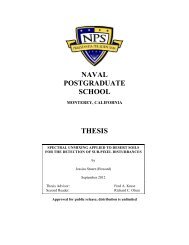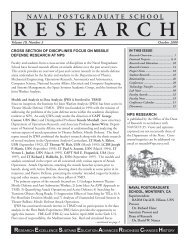High Energy Laser Testbed for Accurate Beam Pointing Control
High Energy Laser Testbed for Accurate Beam Pointing Control
High Energy Laser Testbed for Accurate Beam Pointing Control
Create successful ePaper yourself
Turn your PDF publications into a flip-book with our unique Google optimized e-Paper software.
Figure 24. Frequency Domain NFOV track error, FX-RLS algorithm<br />
4.2 <strong>Beam</strong> Jitter <strong>Control</strong><br />
Since additional rate gyros <strong>for</strong> strap-down type IRU implementation was not available at the time, a demonstration was<br />
conducted using the gimbal rate gyro. This gyro signal is applied as a feed<strong>for</strong>ward control without adaptive filters<br />
implemented on the testbed. To accomplish feed<strong>for</strong>ward control, the transfer function between the gyro and the FSM is<br />
required. This transfer function was developed using two tests, the first to determine the transfer function between the<br />
error at the PSD and the gyro and the second a transfer function between the FSM and the error at the PSD. Disturbance<br />
motion in both tests was detected by the PSD. This transfer function is summarized in equations 14 through 17 where<br />
y psd is the error measured at the PSD, G g is the transfer function between the gyro and the PSD, g is the gyro signal,<br />
G FSM is the transfer function between the FSM and PSD and u is the control signal to the FSM. The FSM is modeled<br />
as a second order LPF. A system identification was conducted to determine G g , which is a first order transfer function.<br />
y psd = Gg g<br />
(14)<br />
ypsd = − GFSMu (15)<br />
G<br />
=− (16)<br />
g<br />
u g<br />
GFSM<br />
1<br />
Gg<br />
= ; τ = 1.6<br />
(17)<br />
s + τ<br />
Since this was only a demonstration of the feasibility of strap-down type IRU implementation, the disturbance was<br />
limited to 5 Hz. The gains <strong>for</strong> both g G and G FSM were optimized <strong>for</strong> 5 Hz.<br />
Experimental results <strong>for</strong> the gyro feed<strong>for</strong>ward controller can be seen in Figures 25 and 26. The 5 Hz disturbance was<br />
turned on just prior to 3 seconds, and the feed<strong>for</strong>ward controller was turned on after 6 seconds. It should be noted there<br />
was a boresight error, which caused the target error to be non-zero prior to application of the disturbance. By using the<br />
Proc. of SPIE Vol. 7587 75870G-17<br />
Downloaded from SPIE Digital Library on 31 Jul 2012 to 205.155.65.56. Terms of Use: http://spiedl.org/terms
















